The Study of the Effect of Blade Sharpening Conditions on the Lifetime of Planar Knives During Industrial Flatfish Skinning Operations
Abstract
1. Introduction
2. Materials and Methods
2.1. Materials—Characterization of Soft Tissue Specimens
2.2. Materials—Planar Knives
2.3. Selected Conditions for the Grinding Process
2.4. Details of Operational Experiments on Knives
- washing in a solution prepared by mixing 100 mL of the chemical agent Diversey Sureclean Plus VK9 per 10 L of water (Diversey Inc., Fort Mill, SC, USA);
- rinsing under running water;
- sterilization at a temperature of 82–85 °C for 10 min;
- application of a sprayed alcohol-based chemical agent Diversey Divodes FG VT29 (Diversey Inc., Fort Mill, SC, USA), which is a ready-to-use solution that evaporates shortly after application, leaving the knives in a condition suitable for use in food processing.
- the safety cover of the working section was raised, and the pressing rollers and transport rollers section was opened;
- the working parts of the skinning machine were rinsed with running water to remove residues of the processed raw material;
- the clamping screws of the knife support were unscrewed, and the worn knife was removed, followed by installation of a new reference knife or a knife regenerated through the grinding process;
- after tightening the clamping screws of the knife support, the pressing and transport rollers section along with the safety cover was closed;
- production was resumed, and timing measurements were initiated.
3. Results and Discussion
- -
- the central horizontal line inside each box denotes the median;
- -
- the top and bottom edges of the box represent the upper and lower quartiles, respectively—together defining the interquartile range (IQR);
- -
- whiskers extend to the minimum and maximum values within 1.5× IQR from the quartiles, showing the spread of the central portion of the data;
- -
- hatched bars (mean ± SE) represent the mean tool life along with the standard error (SE) of the mean—indicating the precision of the mean estimate.
3.1. Statistical Analysis of Significance
3.2. Comparative Assessment of Tool Life and Material Removal Under Various Cooling Strategies
4. Conclusions
- In the case of edge shaping of knives during grinding performed under conditions established based on previously conducted research results, it can be concluded that the cutting properties of the blades are correctly restored, at least to the level characteristic of the reference knives. This enables the reuse of knives in the flatfish skinning process while simultaneously ensuring an extended operational cycle for these tools in most cases.
- Operational testing of technical knives, regardless of the cooling method applied during their edge shaping process, demonstrated very good cutting performance of the blades. The possibility of multiple reuses of the same knives translates into tangible economic and operational benefits, such as a reduction in the number of tool changeovers.
- Edge shaping of planar blades of technical knives under flood cooling (WET) and hybrid cooling methods (combining MQL and CAG) allowed an extension of the tool life during the skinning of plaice (Pleuronectes platessa) by 12.39% and 8.85%, respectively. This gain is significant enough to correspond both to a comparable increase in the quantity of processed raw material and to time savings of approximately 2035 min per year (about 34 working hours), resulting from the reduced frequency of production stoppages for tool replacement. The relative increase in effective tool life of refurbished technical knives in the flounder skinning process (Platichthys flesus) is even greater, amounting to 17.7% and 16.3% for the WET and HYB methods, respectively. The assumed annual time savings for changeovers in this case reach as much as 2883 min, approximately 48 working hours.
- Supplementing the MQL cooling method during grinding with additional cooling by supplying chilled compressed air generated through the CAG nozzle effectively improves heat dissipation from the machining zone. This allows for the formation of technical blades whose operational tool life is only slightly lower than that of knives shaped under flood cooling (WET) conditions. This difference ranges from −3.7% to −12% in tool life in favor of the flood cooling method. Importantly, the use of a hybrid cooling and lubrication system in the grinding zone enables over a 95-fold reduction in coolant consumption, significantly reducing costs associated with its purchase and disposal.
- The use of refurbished knives had no negative impact on the production process. It was observed that the processed fish fillets did not exhibit damage signs such as delamination. Organoleptic evaluation by experienced production personnel revealed no qualitative differences compared to the process conducted using reference knives.
Author Contributions
Funding
Institutional Review Board Statement
Informed Consent Statement
Data Availability Statement
Conflicts of Interest
Nomenclature
| CAG | grinding fluid in the form of cooled air using cold air guns (cold compressed air method) |
| HSB | color space; HSB stands for hue, saturation, and brightness |
| IQR | interquartile range (a measure of statistical dispersion) |
| LCL | lower confidence intervals of the parameter |
| MQL | technique of cooling in the grinding process with minimum quantity lubrication |
| UCL | upper confidence intervals of the parameter |
| SE | standard error of a statistic (estimator of a parameter) |
| WET | conventional flood method in the grinding process using water emulsion as coolant |
| α | statistical significance level |
| ||A||F | distance from an ideal point (Frobenius distance) |
| ae | machining allowance (working engagement) for rough passage, mm |
| aes | allowance for sparking-out phase, mm |
| Fc | cutting force, N |
| F-value | result of a statistical test in ANOVA, where the test statistic follows Snedecor’s F-distribution |
| GT/GTval | grinding type (categorial variable); numerical value of category is GTval |
| MeanDiff | mean difference between data groups |
| ns | grinding wheel rotational speed, rev/min |
| P | grinding power, W |
| Prob | probability of observing a test statistic |
| Sig | significance flag (indicates that a pair of groups is significantly different in a pairwise comparison test) |
| t-value | value of a statistical test obtained using Student’s t-test |
| vf | feed speed in the grinding process; precisely the longitudinal feed speed of the grinding wheel, mm/min |
Appendix A
| Group | Label | Lifetime (minutes) | Avg. Time (minutes) | SE of Mean (minutes) | Processed Mass (kg) | Avg. Mass (kg) | SE of Mean (kg) |
|---|---|---|---|---|---|---|---|
| Reference knifes | REF#1 | 105 | 113 | 5.29 | 147 | 158 | 7.37 |
| REF#2 | 123 | 172 | |||||
| REF#3 | 111 | 155 | |||||
| Sum: | 339 | — | — | 474 | — | — | |
| Ground knifes | WET#1 | 135 | 127 | 4.16 | 189 | 177.66 (6) | 5.93 |
| WET#2 | 121 | 169 | |||||
| WET#3 | 125 | 175 | |||||
| Sum: | 381 | — | — | 533 | — | — | |
| MQL#1 | 114 | 111.33 (3) | 4.81 | 155 | 151.33 (3) | 6.33 | |
| MQL#2 | 118 | 160 | |||||
| MQL#3 | 102 | 139 | |||||
| Sum: | 334 | — | — | 454 | — | — | |
| HYB#1 | 126 | 123 | 5.69 | 181 | 177 | 8.32 | |
| HYB#2 | 112 | 161 | |||||
| HYB#3 | 131 | 189 | |||||
| Sum: | 369 | — | — | 531 | — | — | |
| Overall: | — | 1423 | 118.58 | 2.92 | 1992 | 166 | 4.61 |
| Groups of Means (pairs) | MeanDiff * | t-Value | Prob ** | Sig *** | LCL | UCL |
|---|---|---|---|---|---|---|
| Lifetime of Technical Knife | ||||||
| WET-REF | 14 | 1.97 | 0.084 | 1 | 0.79 | 27.20 |
| MQL-REF | −1.67 | −0.23 | 0.820 | 0 | −14.86 | 11.53 |
| MQL-WET | −15.67 | −2.20 | 0.058 | 1 | −28.86 | −2.46 |
| HYB-REF | 10 | 1.41 | 0.196 | 0 | −3.20 | 23.20 |
| HYB-WET | −4 | −0.56 | 0.588 | 0 | −17.20 | 9.20 |
| HYB-MQL | 11.67 | 1.64 | 0.138 | 0 | −1.53 | 24.86 |
| Processed mass of fish | ||||||
| WET-REF | 19.67 | 1.97 | 0.083 | 1 | 1.12 | 38.21 |
| MQL-REF | −6.67 | −0.67 | 0.523 | 0 | −25.21 | 11.87 |
| MQL-WET | −26.33 | −2.64 | 0.029 | 1 | −44.87 | −7.78 |
| HYB-REF | 19 | 1.90 | 0.093 | 1 | 0.45 | 37.54 |
| HYB-WET | −0.67 | −0.07 | 0.948 | 0 | −19.21 | 17.87 |
| HYB-MQL | 25.67 | 2.57 | 0.032 | 1 | 7.12 | 44.21 |
| Group | Label | Lifetime (minutes) | Avg. Time (minutes) | SE of Mean (minutes) | Processed Mass (kg) | Avg. Mass (kg) | SE of Mean (kg) |
|---|---|---|---|---|---|---|---|
| Reference knifes | REF#4 | 48 | 45 | 1.53 | 80 | 75 | 2.52 |
| REF#5 | 44 | 73 | |||||
| REF#6 | 43 | 72 | |||||
| Sum: | 135 | — | — | — | — | ||
| Ground knifes | WET#4 | 51 | 53 | 1.53 | 85 | 88.33 (3) | 2.40 |
| WET#5 | 56 | 93 | |||||
| WET#6 | 52 | 87 | |||||
| Sum: | 159 | — | — | — | — | ||
| MQL#4 | 53 | 51 | 1.15 | 87 | 83.66 (6) | 2.03 | |
| MQL#5 | 51 | 84 | |||||
| MQL#6 | 49 | 80 | |||||
| Sum: | 153 | — | — | — | — | ||
| HYB#4 | 50 | 52.33 (3) | 1.20 | 84 | 88 | 2.08 | |
| HYB#5 | 54 | 91 | |||||
| HYB#6 | 53 | 89 | |||||
| Sum: | 157 | — | — | — | — | ||
| Overall: | — | 604 | 50.33 (3) | 1.12 | 1005 | 83.75 | 1.89 |
| Groups of Means (pairs) | MeanDiff * | t-Value | Prob ** | Sig *** | LCL | UCL |
|---|---|---|---|---|---|---|
| Lifetime of Technical Knife | ||||||
| WET-REF | 8 | 4.14 | 0.003 | 1 | 3.55 | 12.45 |
| MQL-REF | 6 | 3.11 | 0.014 | 1 | 1.55 | 10.44 |
| MQL-WET | −2 | −1.03 | 0.330 | 0 | −6.45 | 2.45 |
| HYB-REF | 7.33 | 3.80 | 0.005 | 1 | 2.88 | 11.78 |
| HYB-WET | −0.67 | −0.34 | 0.738 | 0 | −5.12 | 3.78 |
| HYB-MQL | 1.33 | 0.69 | 0.509 | 0 | −3.11 | 5.78 |
| Processed mass of fish | ||||||
| WET-REF | 13.33 | 4.16 | 0.003 | 1 | 5.94 | 20.72 |
| MQL-REF | 8.67 | 2.70 | 0.026 | 1 | 1.27 | 16.05 |
| MQL-WET | −4.67 | −1.45 | 0.183 | 0 | −12.06 | 2.72 |
| HYB-REF | 13 | 4.05 | 0.004 | 1 | 5.61 | 20.39 |
| HYB-WET | −0.33 | −0.10 | 0.919 | 0 | −7.72 | 7.05 |
| HYB-MQL | 4.33 | 1.35 | 0.213 | 0 | −3.05 | 11.72 |
References
- Zhang, Q.; Liu, F.; Wu, D.; Qu, S.; Liu, W.; Chen, Z. A Comprehensive Understanding of Knife Cutting: Effects of Hardness, Blade Angle and the Micro-Geometry of Blade Edge on the Cutting Performance. Materials 2023, 16, 5375. [Google Scholar] [CrossRef] [PubMed]
- Kurt, A.; Kose, E.; Sahinbaskan, T. The effects of blade angle on blade stresses during cutting of different kinds of paper materials. Stroj. Vestn.—J. Mech. Eng. 2009, 55, 633–640. Available online: https://www.sv-jme.eu/article/the-effects-of-blade-angle-on-blade-stresses-during-cutting-of-different-kinds-of-paper-materials/ (accessed on 26 May 2025).
- Mehrin, S.; Hasan, M.; Azad, L.R.; Shahin, M.R. Comparative Study on Automatic Fabric Cutting Machine and Straight Knife Cutting Machine. N. Am. Acad. Res. 2022, 5, 103–111. [Google Scholar] [CrossRef]
- Mróz, S.; Stefanik, A.; Szota, P.; Galusińska, S.; Zaława, D.; Adamiec, A.; Zaława, N. Investigation of the Effect of the Shape of Cutting Knives Limiting Burr in High-Strength Multiphase Steel Sheets. Materials 2025, 18, 282. [Google Scholar] [CrossRef] [PubMed]
- Nasr, M.; Yehia, K. Stress Analysis of a Shredder Blade for Cutting Waste Plastics. J. Int. Soc. Sci. Eng. 2019, 1, 9–12. [Google Scholar] [CrossRef]
- Xu, W.; Wang, J.; Deng, Y.; Li, J.; Yan, T.; Zhao, S.; Yang, X.; Xu, E.; Wang, W.; Liu, D. Advanced cutting techniques for solid food: Mechanisms, applications, modeling approaches, and future perspectives. Compr. Rev. Food Sci. Food Saf. 2022, 21, 1568–1597. [Google Scholar] [CrossRef]
- Liu, W.; Lyu, J.; Wu, D.; Cao, Y.; Ma, Q.; Lu, Y.; Zhang, X. Cutting Techniques in the Fish Industry: A Critical Review. Foods 2022, 11, 3206. [Google Scholar] [CrossRef]
- Viatcheslavovich, A.O.; Arkadievich, N.V.; Adgamovich, F.Y. Mathematical simulation of knife profile resistance force during fish cutting. Vestn. Astrakhan State Tech. Univ. Ser. Fish. Ind. 2019, 3, 150–158. [Google Scholar] [CrossRef]
- Ageev, O.V.; Fatykhov, Y.; Ivanova, E.E. Optimization of the knife profile for resource-saving primary fish processing. News of institutes of higher education. Food Technol. 2020, 1, 77–80. [Google Scholar] [CrossRef]
- Ageev, O.; Naumov, V.A.; Fatykhov, J.A. Mathematical Modeling of the Resistance Force of the Profile of a Flat-Back Knife. J. Frict. Wear 2019, 40, 580–587. [Google Scholar] [CrossRef]
- Chu, J.P.; Diyatmika, W.; Tseng, Y.-J.; Liu, Y.-K.; Liao, W.-C.; Chang, S.-H.; Chen, M.-J.; Lee, J.-W.; Jang, J.S.C. Coating Cutting Blades with Thin-Film Metallic Glass to Enhance Sharpness. Sci. Rep. 2019, 9, 15558. [Google Scholar] [CrossRef] [PubMed]
- Komlatsky, V.I.; Podoinitsyna, T.A.; Verkhoturov, V.V.; Kozub, Y.A. Automation technologies for fish processing and production of fish products. J. Phys. Conf. Ser. 2019, 1399, 044050. [Google Scholar] [CrossRef]
- Kapłonek, W.; Nadolny, K.; Zieliński, B.; Plichta, J.; Pimenov, D.Y.; Sharma, S. The Role of Observation-Measurement Methods in the Surface Characterization of X39Cr13 Stainless-Steel Cutting Blades Used in the Fish Processing Industry. Materials 2020, 13, 5796. [Google Scholar] [CrossRef]
- Arnþórsdóttir, M.G.; Arason, S.; Margeirsson, B. Combined Blast and Contact cooling—Effects on physiochemical characteristics of fresh haddock (Melanogrammus aeglefinus) fillets. In Skýrsla Matís; Matís ohf.: Reykjavík, Iceland, 2008; Report no. 14-08, Project no. 1643; ISSN 1670-7192. Available online: https://www.matis.is/media/matis/utgafa/Skyrsla_14-08.pdf (accessed on 20 May 2025).
- Mainali, S.; Li, C. A robotic fish processing line enhanced by machine learning. Aquac. Eng. 2025, 108, 102481. [Google Scholar] [CrossRef]
- Einarsdóttir, H.; Guðmundsson, B.; Ómarsson, V. Automation in the fish industry. Anim. Front. 2022, 12, 32–39. [Google Scholar] [CrossRef]
- Nadolny, K.; Kapłonek, W.; Sutowska, M.; Sutowski, P.; Myśliński, P.; Gilewicz, A. Experimental Studies on Durability of PVD-Based CrCN/CrN-Coated Cutting Blade of Planer Knives Used in the Pine Wood Planing Process. Materials 2020, 13, 2398. [Google Scholar] [CrossRef] [PubMed]
- Nadolny, K.; Kapłonek, W.; Sutowska, M.; Sutowski, P.; Myśliński, P.; Gilewicz, A.; Warcholiński, B. Experimental tests of PVD AlCrN-coated planer knives on planing Scots pine (Pinus sylvestris L.) under industrial conditions. Eur. J. Wood Wood Prod. 2021, 79, 645–665. [Google Scholar] [CrossRef]
- Pancielejko, M.; Czyżniewski, A.; Gilewicz, A.P.; Zavaleyev, V.; Szymański, W. The cutting properties and wear of the knives with DLC and W-DLC coatings, deposited by PVD methods, applied for wood and wood-based materials machining. Arch. Mater. Sci. Eng. 2012, 58, 235–244. Available online: http://www.amse.acmsse.h2.pl/vol58_2/58222.pdf (accessed on 18 May 2025).
- Świetlicki, A.; Szala, M.; Walczak, M. Effects of Shot Peening and Cavitation Peening on Properties of Surface Layer of Metallic Materials-A Short Review. Materials 2022, 15, 2476. [Google Scholar] [CrossRef]
- Sutowski, P.; Zieliński, B.; Nadolny, K. Advanced regression model fitting to experimental results in case of the effect of grinding conditions on a cutting force with the planer technical knives. Measurement 2025, 241, 115717. [Google Scholar] [CrossRef]
- Zieliński, B.; Kapłonek, W.; Sutowska, M.; Nadolny, K. Analysis of a Feasibility Study of a Precision Grinding Process for Industrial Blades Used in the Cutting of Soft Tissues by a Prototype 5-Axis CNC Grinding Machine. Appl. Sci. 2019, 9, 3883. [Google Scholar] [CrossRef]
- Zieliński, B.; Chaciński, T.; Pimenov, D.Y.; Nadolny, K. Methodology for Evaluating the Cutting Force of Planar Technical Blades Used in Flatfish Processing. Micromachines 2021, 12, 1516. [Google Scholar] [CrossRef] [PubMed]
- Zieliński, B.; Nadolny, K.; Zawadka, W.; Chaciński, T.; Stachurski, W.; Batalha, G.F. Effect of Pro-Ecological Cooling and Lubrication Methods on the Sharpening Process of Planar Blades Used in Food Processing. Materials 2022, 15, 7842. [Google Scholar] [CrossRef]
- Zieliński, B.; Nadolny, K.; Zawadka, W.; Chaciński, T.; Stachurski, W.; Batalha, G.F. Effect of the Granularity of Cubic Boron Nitride Vitrified Grinding Wheels on the Planar Technical Blades Sharpening Process. Materials 2022, 15, 7989. [Google Scholar] [CrossRef] [PubMed]
- Chaciński, T.; Zieliński, B.; Nadolny, K. Effect of Feed Rate on the Force and Energy in the Cutting Process Using Planar Technical Blades. Appl. Sci. 2023, 13, 2013. [Google Scholar] [CrossRef]
- Nugroho, A.K.; Afiahayati, A.; Wibowo, M.E.; Soebono, H.; Wardoyo, R. Skin Lesion Segmentation Using Adaptive Color Segmentation and Decision Tree. J. Wirel. Mob. Netw. Ubiquitous Comput. Dependable Appl. 2024, 15, 109–124. [Google Scholar] [CrossRef]
- Zheng, K.; Tian, L.; Cui, J.L.; Liu, J.H.; Li, H.; Zhou, J.; Zhang, J.J. An Adaptive Thresholding Method for Facial Skin Detection in HSV Color Space. IEEE Sens. J. 2025, 25, 3098–3109. [Google Scholar] [CrossRef]
- Ganesan, P.; Sathish, B.S.; Leo Joseph, L.M.I.; Sajiv, G.; Murugesan, R.; Akilandeswari, A. HSV Model based Skin Color Segmentation using Uncomplicated Threshold and Logical AND Operation. In Proceedings of the 9th International Conference on Advanced Computing and Communication Systems (ICACCS), Coimbatore, India, 17–18 March 2023; pp. 415–419. [Google Scholar] [CrossRef]
- BS EN 10088-3:2023; Stainless Steels – Part 3: Technical Delivery Conditions for Semi-Finished Products, Bars, Rods and Sections for General Purposes. British Standards Institution: London, UK, 2023.
- BS EN 10088-1:2014; Stainless Steels – Part 1: List of Stainless Steels. British Standards Institution: London, UK, 2014.
- Rao, R.V.; Rai, D.P.; Ramkumar, J.; Balic, J. A new multi-objective Jaya algorithm for optimization of modern machining processes. Adv. Prod. Eng. Manag. 2016, 11, 271–286. [Google Scholar] [CrossRef][Green Version]
- Rao, R.V. Jaya: A simple and new optimization algorithm for solving constrained and unconstrained optimization problems. Int. J. Ind. Eng. Comput. 2016, 7, 19–34. [Google Scholar] [CrossRef]
- Golub, G.H.; Van Loan, C.F. Matrix Computations, 4th ed.; Johns Hopkins University Press: Baltimore, MD, USA, 2013; ISBN 978-1-4214-0859-0. [Google Scholar]
- Weinert, K.; Inasaki, I.; Sutherland, J.; Wakabayashi, T. Dry machining and minimum quantity lubrication. CIRP Annals 2004, 53, 511–537. [Google Scholar] [CrossRef]
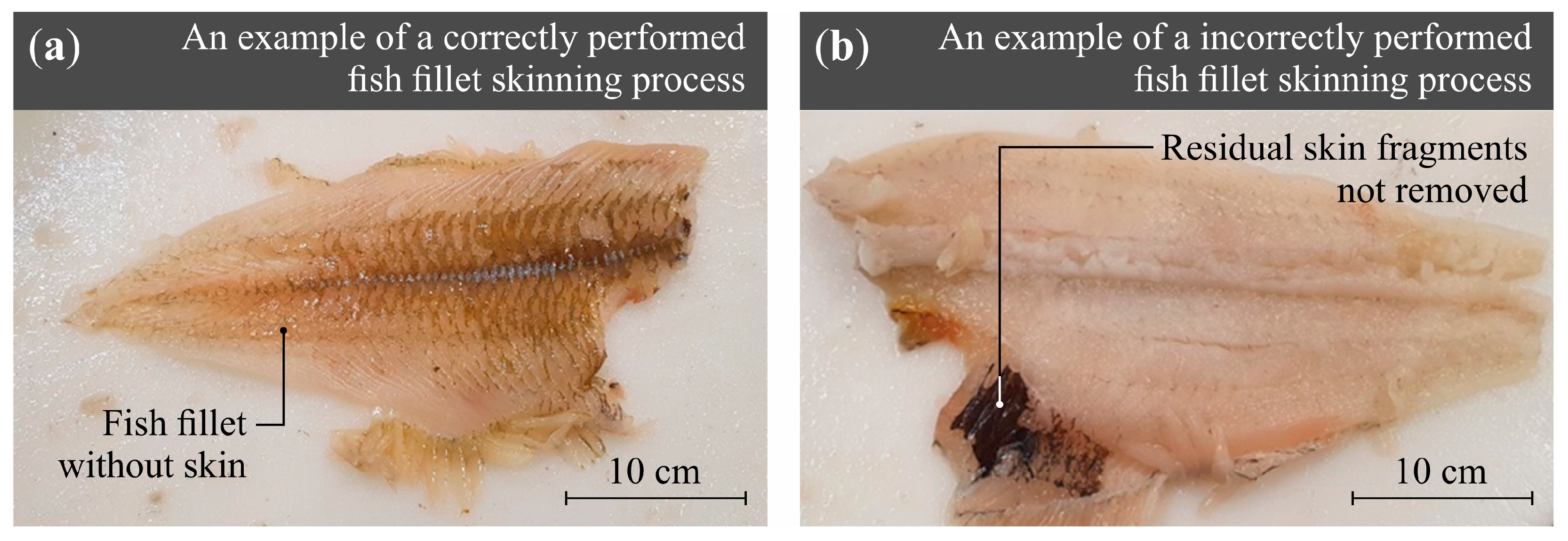
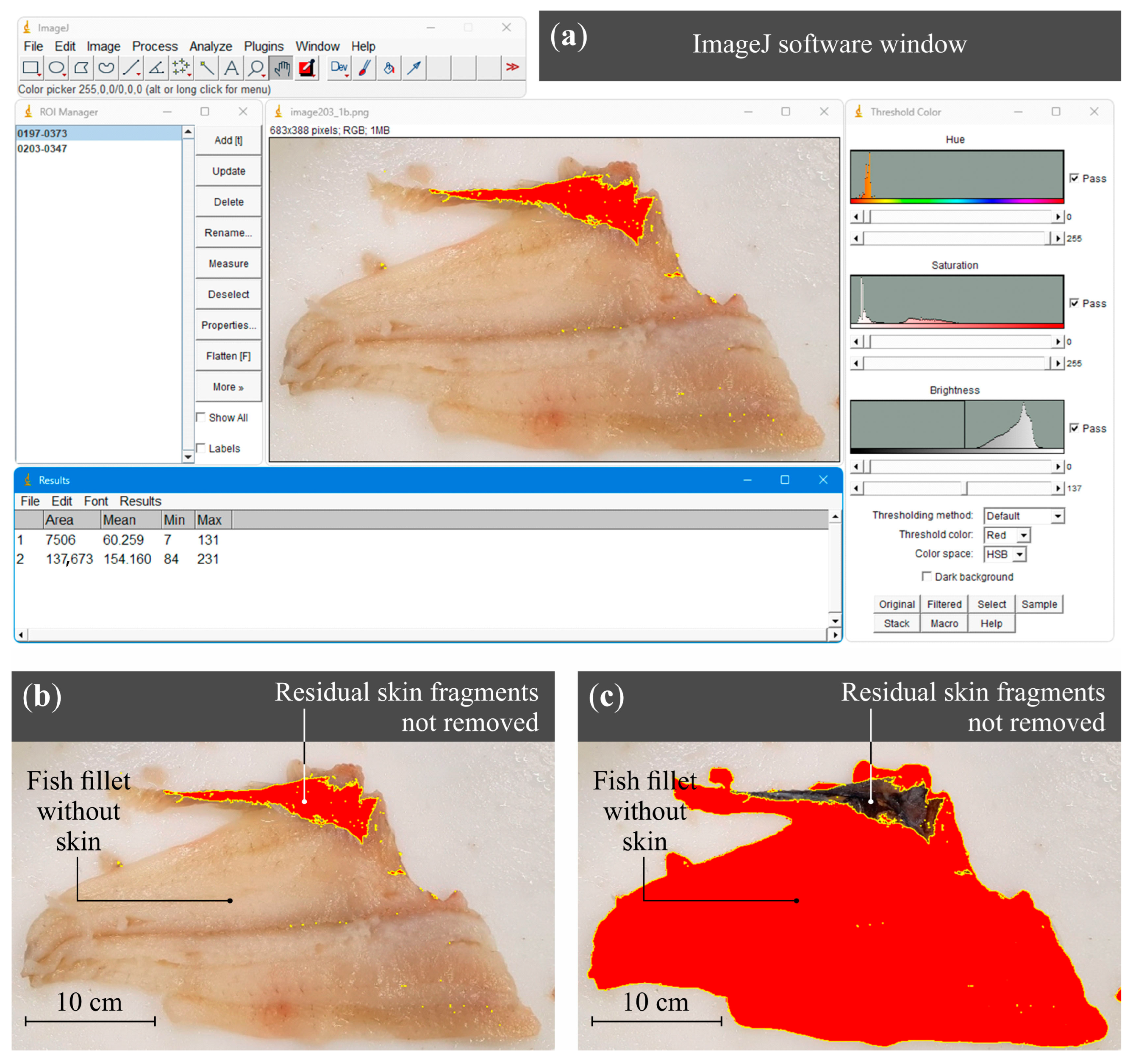
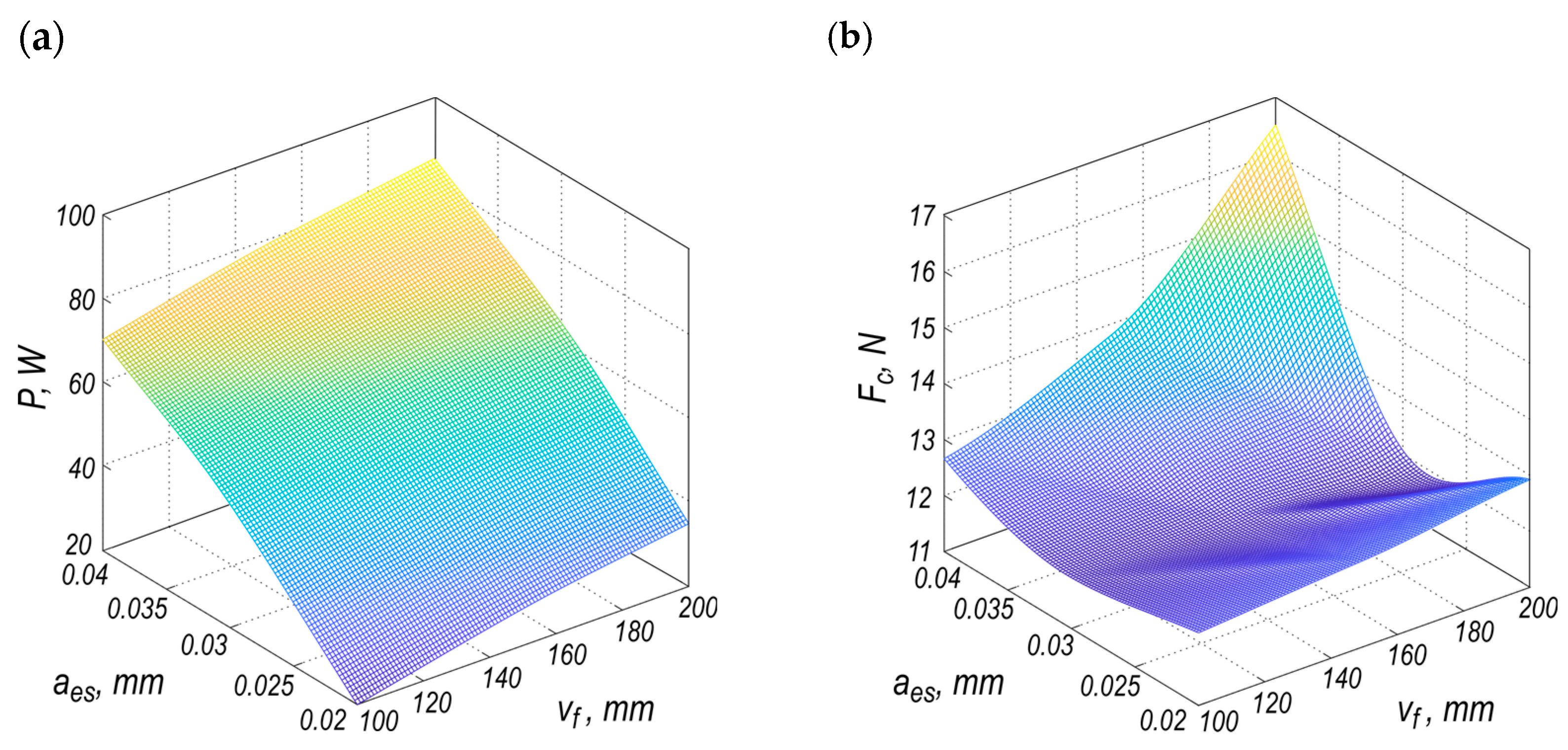


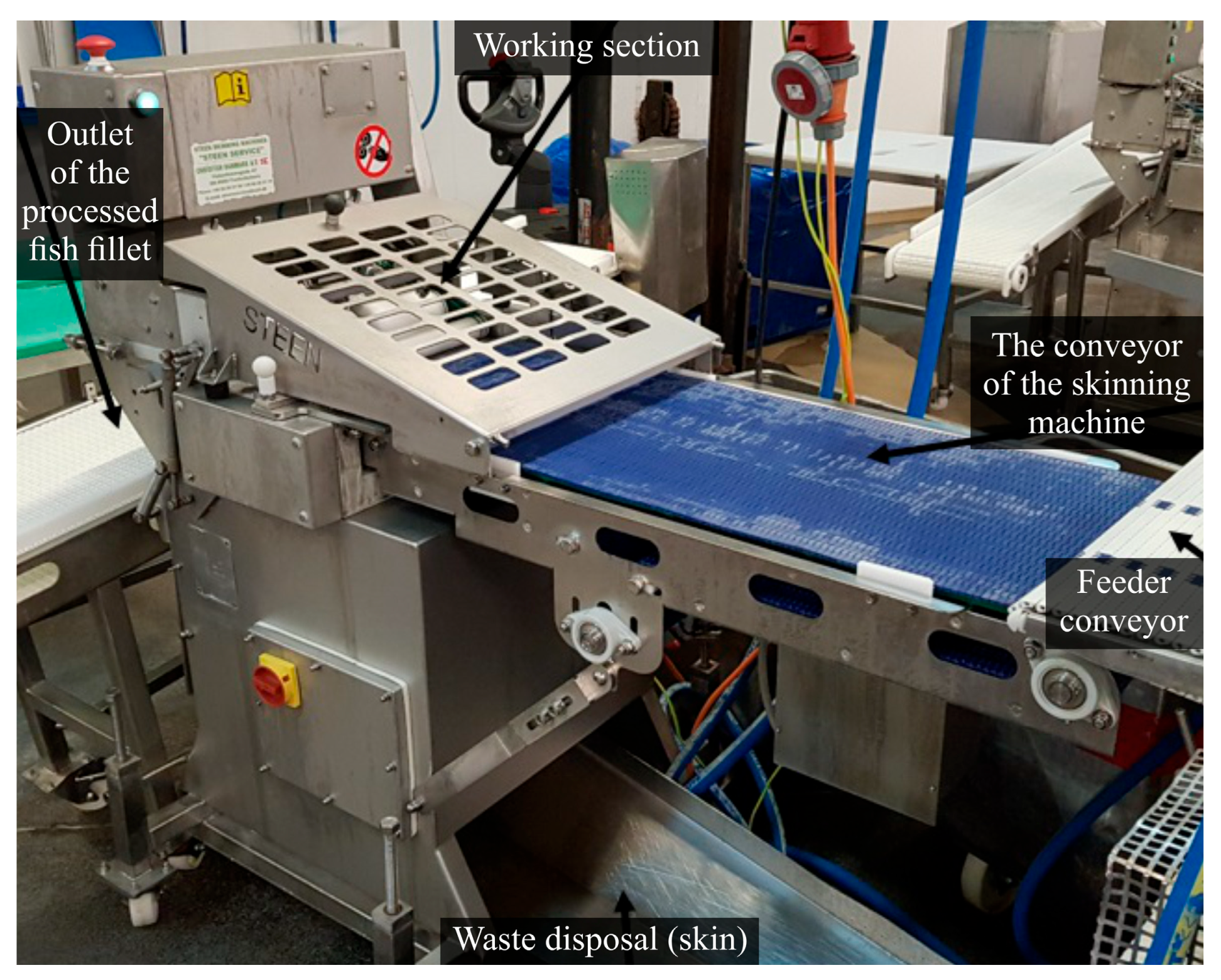
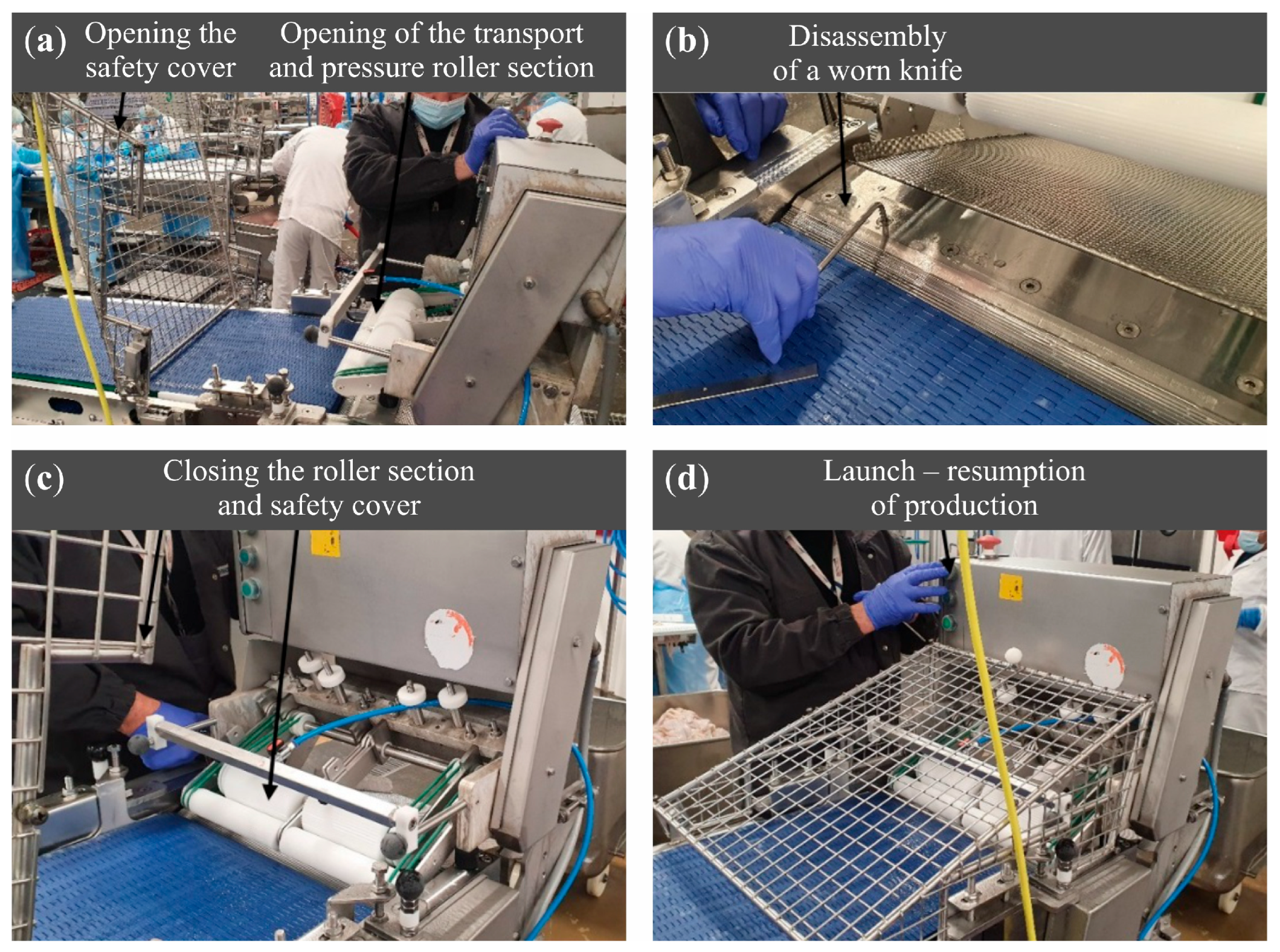
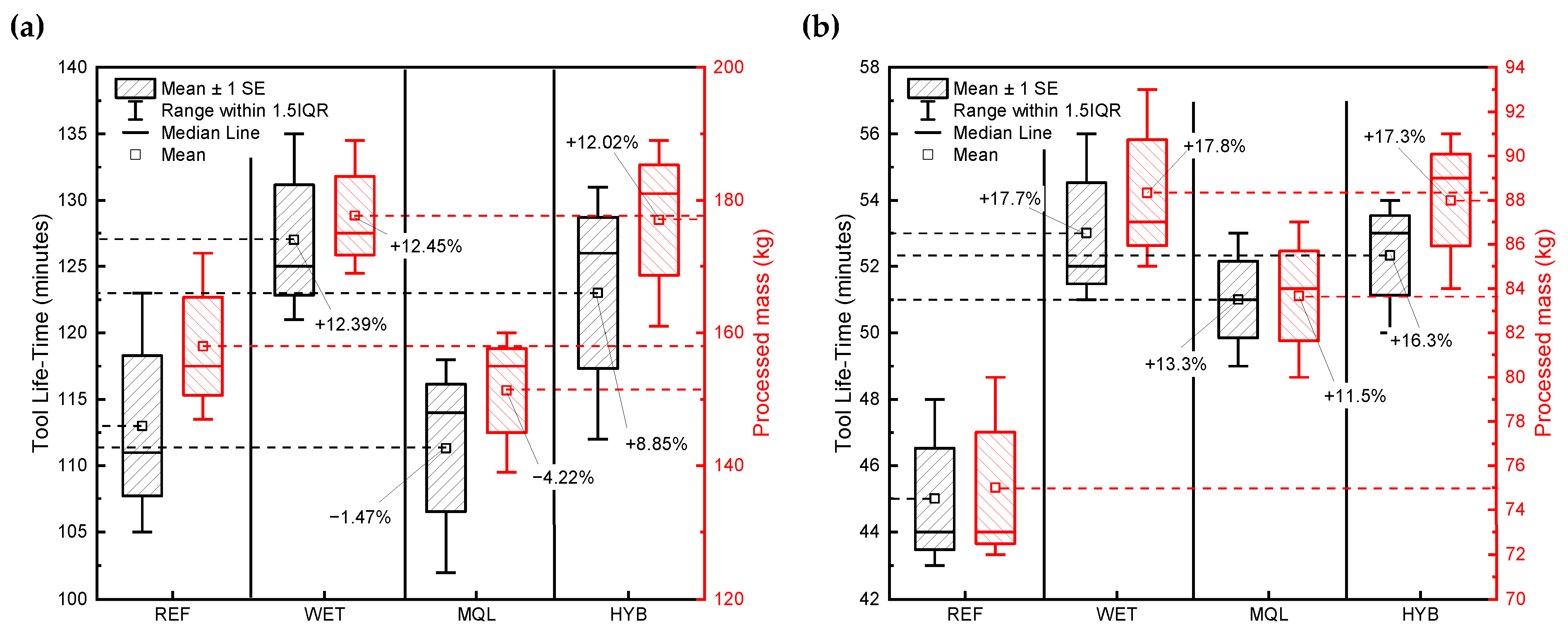
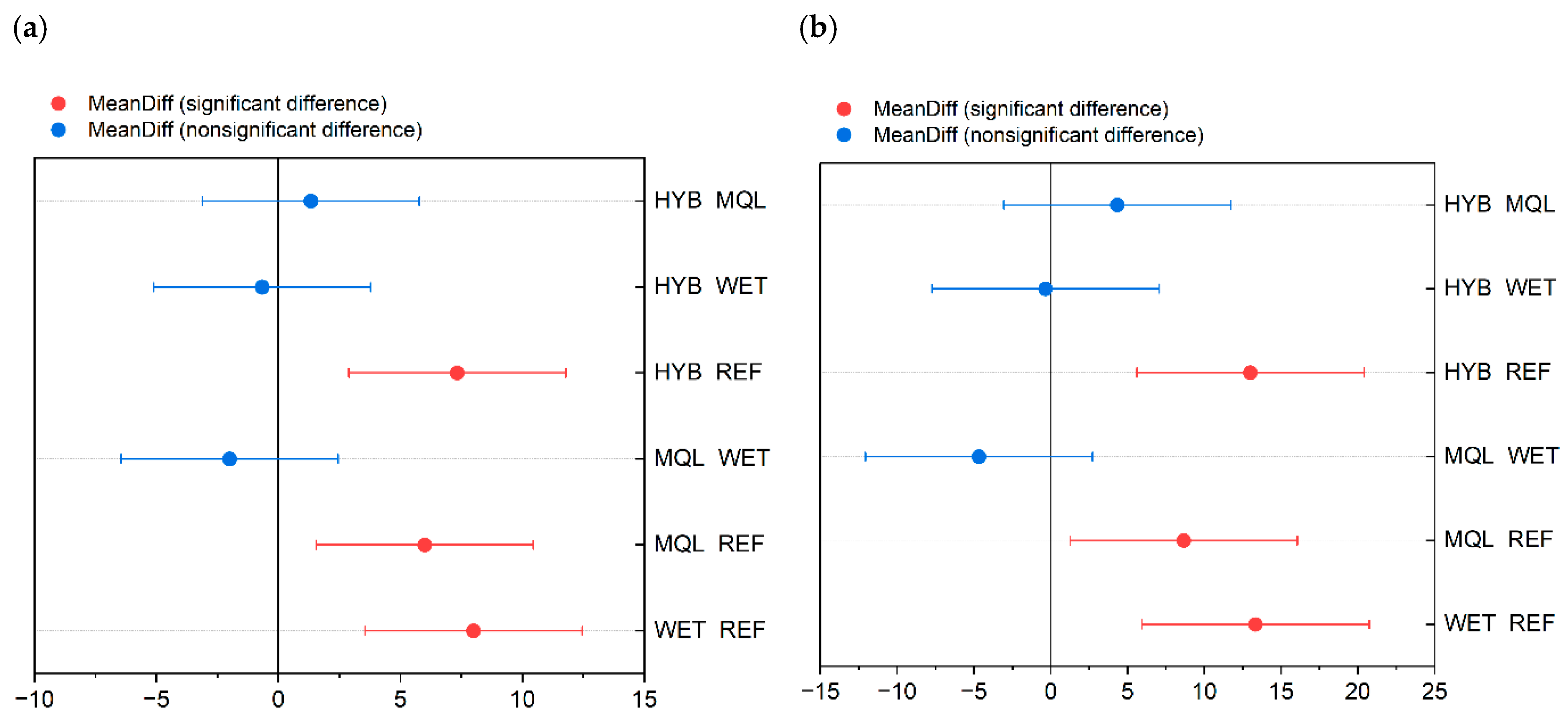
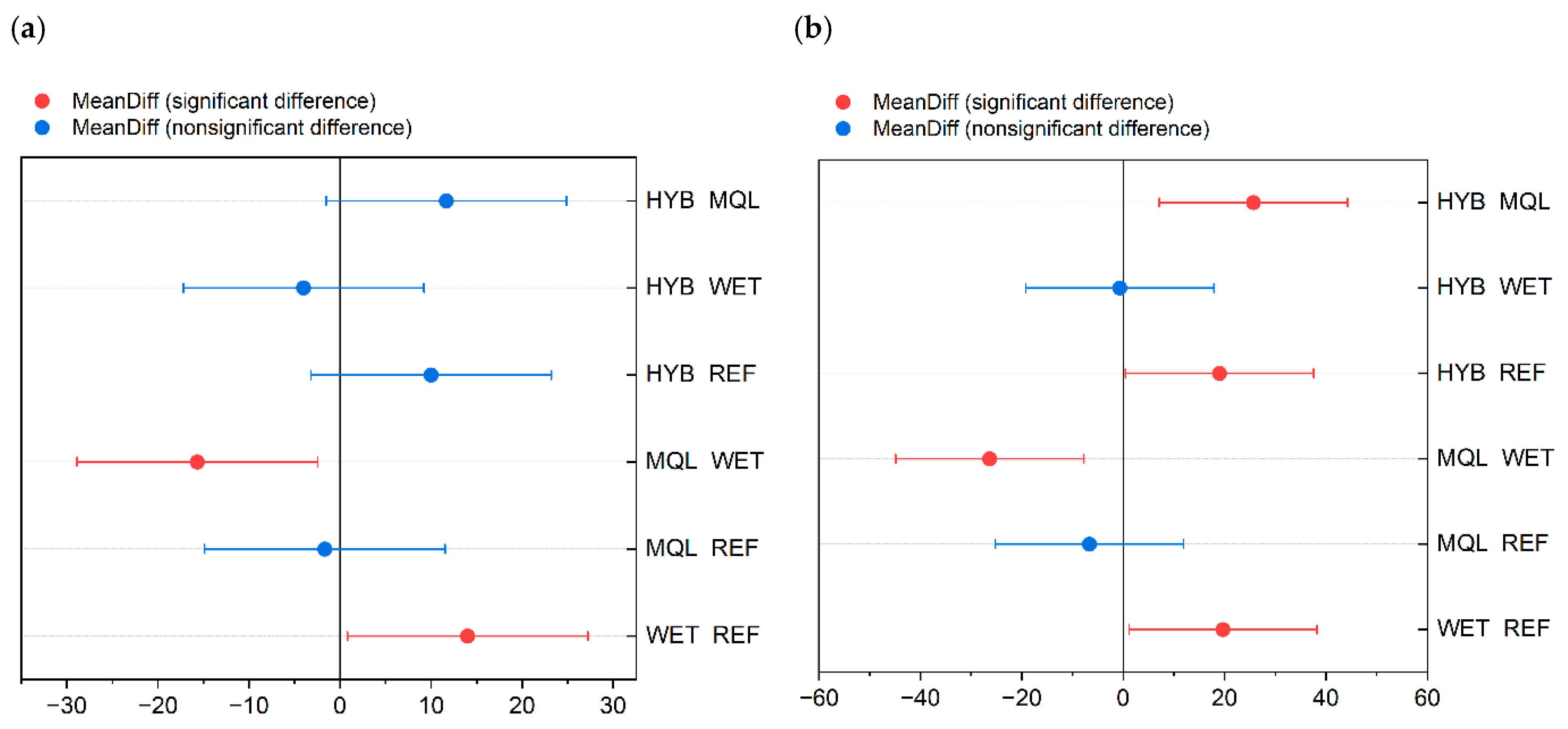
| Characteristic | Plaice (Pleuronectes platessa) | Flounder (Platichthys flesus) |
|---|---|---|
| Weight before filleting (whole fish) | 218 to 283 g | 242 to 305 g |
| Weight before skinning (single fillet) | 90 to 113 g | 44 to 51 g |
| Storage form | Delivered fresh (not frozen during transport) | Delivered frozen (subjected to thawing at the processing plant) |
| Temperature during transport | 0–2 °C | −18 °C |
| Cr | C | Si | P | S | Mn |
|---|---|---|---|---|---|
| 12.5 to 14.5 | 0.36 to 0.42 | max. 1.00 | max. 0.04 | max. 0.03 | max. 1.00 |
| Density at 20 °C | Modulus of elasticity at 20 °C | Heat conductivity coefficient | Specific heat at 20 °C | Electrical resistivity at 20 °C |
| 7.7 kg/dm3 | 215 GPa | 30 W/m·K | 460 J/kg·K | 0.55 (Ω·mm2)/m |
| Brinell hardness (HB) | Yield strength (0.2% offset, Rp0.2) | Tensile strength (Rm) | Elongation after fracture (A) | Impact energy (KV) (ISO-V, longitudinal) |
| max. 245 | 650 MPa | 800 to 1000 MPa | min. 10% | KV ≥ 12 J |
| vf (mm/min) | aes (mm) | P (W) | Fc (N) | ||A||F |
|---|---|---|---|---|
| 100 | 0.03 | 49.10 | 11.91 | 29.63 |
| 100 | 0.03 | 49.10 | 11.91 | 29.63 |
| 100 | 0.02 | 19.46 | 12.30 | 0.39 |
| 100 | 0.02 | 19.46 | 12.30 | 0.39 |
| 100 | 0.03 | 49.10 | 11.91 | 29.63 |
| 100 | 0.02 | 19.46 | 12.30 | 0.39 |
| 100 | 0.03 | 49.10 | 11.91 | 29.63 |
| 100 | 0.03 | 49.10 | 11.91 | 29.63 |
| 100 | 0.02 | 19.46 | 12.30 | 0.39 |
| Grinding Wheel Rotational Speed (ns) | Allowance for Rough Pass (ae) | Allowance for Spark-Out Pass (aes) | Grinding Wheel Longitudinal Feed Rate (vf) |
|---|---|---|---|
| 32,000 rev/min | 0.1 mm | 0.02 mm | 100 mm/min |
| Group | Label | Grinding Conditions | Lubricating Agent | Cooling Agent | Heat Capacity * (Cp) |
|---|---|---|---|---|---|
| Reference knifes | RK | unknown | unknown | unknown | — |
| Ground knifes | WET | Flood cooling method | Fluid: 5% water solution of oil Oil: Emulgol ES-12 oil Flow rate (Orlen, Plock, Poland): 1750 mL per min (105 L per hour) | Water: 4.18 kJ/kg·K | |
| MQL | Minimum quantity lubrication with coolant–lubricant fluid using an MQL-type Micro-Jet MKS-G100 system manufactured by MicroJet (Karlsruhe, Germany) | Oil-mist Oil: Cimtech (Cimcool Industrial Products, Vlaardingen, The Netherlands)® MQL Supply air pressure: 0.6 MPa Flow rate: 1100 mL per hour | Oil: 1.92 kJ/kg·K | ||
| HYB | Minimum quantity lubrication with coolant–lubricant fluid using an MQL nozzle combined with cooling by cooled compressed air supplied through a CAG nozzle | Emulsion (Water+Oil) Oil: Cimtech® MQL Supply air pressure: 0.6 MPa Flow rate: 1100 mL per hour | Compressed cooled air Nozzle: Vortec 610 Temperature of CCA: −5 °C Flow rate: 50 L per minute | Oil: 1.92 kJ/kg·K Air: 1.04 kJ/kg·K |
| Parameter | Value |
|---|---|
| Ambient temperature | 16–18 °C |
| Temperature of running water (rinsing nozzles of the skinning machine and manual filleting table) | 2–5 °C |
| Feed conveyor speed | 10 m/min |
| Skinning machine conveyor speed | 19 m/min |
| Flow rate of rinsing water from skinning machine nozzles | 2.5 dm3/min |
| Group | Labels | Grinding Conditions * |
|---|---|---|
| Reference knifes | REF#1 to REF#6 | unknown |
| Ground knifes | WET#1 to WET#6 | Flood cooling method (WET) |
| MQL#1 to MQL#6 | Minimum quantity lubrication (MQL) cooling-lubrication using an MQL nozzle | |
| HYB#1 to HYB#6 | Minimum quantity lubrication (MQL) cooling-lubrication combined with cooled compressed air cooling using a CAG nozzle |
| Degrees of Freedom | Sum of Squares | Mean Square | F-Value | Prob > F * | |
|---|---|---|---|---|---|
| Lifetime of the technical knife | |||||
| Model | 3 | 120 | 40 | 7.16 | 0.012 |
| Error | 8 | 44.67 | 5.58 | ||
| Total | 11 | 164.67 | |||
| Processed mass of fish | |||||
| Model | 3 | 346.92 | 115.64 | 7.50 | 0.010 |
| Error | 8 | 123.33 | 15.42 | ||
| Total | 11 | 470.25 | |||
| Degrees of Freedom | Sum of Squares | Mean Square | F-Value | Prob > F * | |
|---|---|---|---|---|---|
| Lifetime of Technical Knife | |||||
| Model | 3 | 522.25 | 174.08 | 2.30 | 0.154 |
| Error | 8 | 604.67 | 75.58 | ||
| Total | 11 | 1126.92 | |||
| Processed mass of fish | |||||
| Model | 3 | 1608.67 | 536.22 | 3.59 | 0.065 |
| Error | 8 | 1193.33 | 149.17 | ||
| Total | 11 | 2802 | |||
| Parameter | Value | |
|---|---|---|
| Average annual number of knives consumed | 4240 pieces per year | |
| Total tool replacement time (approx. 4 min per piece) | 282.67 h per year | |
| Raw material species | Plaice (Pleuronectes platessa) | Flounder (Platichthys Flesus) |
| Percentage gain (in case of extended tool life) | +12% | +17% |
| Estimated average reduction in the number of knives consumed (in case of extended tool life) | 508 pieces per year | 720 pieces per year |
| Estimated average production time saved (in case of extended tool life) | 2035 min per year | 2883 min per year |
Disclaimer/Publisher’s Note: The statements, opinions and data contained in all publications are solely those of the individual author(s) and contributor(s) and not of MDPI and/or the editor(s). MDPI and/or the editor(s) disclaim responsibility for any injury to people or property resulting from any ideas, methods, instructions or products referred to in the content. |
© 2025 by the authors. Licensee MDPI, Basel, Switzerland. This article is an open access article distributed under the terms and conditions of the Creative Commons Attribution (CC BY) license (https://creativecommons.org/licenses/by/4.0/).
Share and Cite
Sutowski, P.; Zieliński, B.; Nadolny, K. The Study of the Effect of Blade Sharpening Conditions on the Lifetime of Planar Knives During Industrial Flatfish Skinning Operations. Materials 2025, 18, 3191. https://doi.org/10.3390/ma18133191
Sutowski P, Zieliński B, Nadolny K. The Study of the Effect of Blade Sharpening Conditions on the Lifetime of Planar Knives During Industrial Flatfish Skinning Operations. Materials. 2025; 18(13):3191. https://doi.org/10.3390/ma18133191
Chicago/Turabian StyleSutowski, Paweł, Bartosz Zieliński, and Krzysztof Nadolny. 2025. "The Study of the Effect of Blade Sharpening Conditions on the Lifetime of Planar Knives During Industrial Flatfish Skinning Operations" Materials 18, no. 13: 3191. https://doi.org/10.3390/ma18133191
APA StyleSutowski, P., Zieliński, B., & Nadolny, K. (2025). The Study of the Effect of Blade Sharpening Conditions on the Lifetime of Planar Knives During Industrial Flatfish Skinning Operations. Materials, 18(13), 3191. https://doi.org/10.3390/ma18133191






